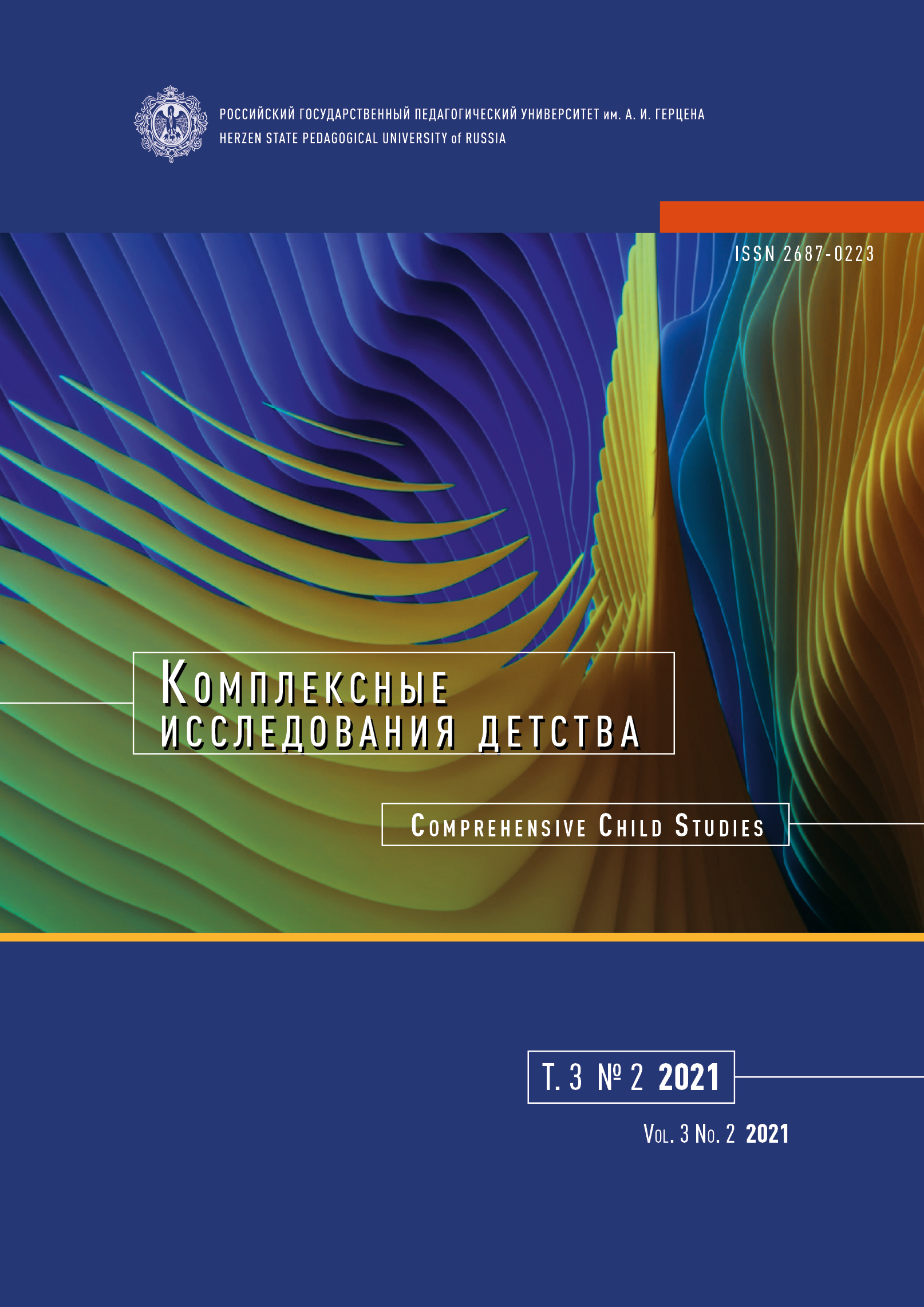Psychological diagnosis of postnatal depression in mothers of prematurely born children
DOI:
https://doi.org/10.33910/2687-0223-2021-3-2-138-144Keywords:
diagnostics, psychological diagnostics, postnatal depression, mothers of prematurely born children, diagnostics of postnatal depressionAbstract
The article reports the results of the study of emotional interaction between mothers and their prematurely born children. In particular, it discusses the tools to diagnose the probability of postnatal depression in mothers of prematurely born children. The article provides a review of international research of the last six years on the impact of maternal depression and anxiety on the interaction with a premature baby. It also focuses on the degree of psychological distress, anxiety and stress reactions associated with. The theoretical analysis of the issue in question has shown the need for early diagnosis of postnatal depression in mothers of prematurely born children. A survey of 234 mothers of prematurely born children showed that they could develop postnatal depression at different stages of the study. The reason lies in the approaches to diagnosis. At the first stage, diagnosis was carried out within a group at the first meeting of mothers of preterm babies with a psychologist. At the second stage the sample was diagnosed by an already familiar psychologist. The differences in data on a sample of mothers of prematurely born children were identified with the most well-known and popular methods: the Edinburgh Postnatal Depression Scale (J. L. Cox, J. M. Holden, R. Sagovsky) and the Postpartum Depression Screening Scale (A. T. Beck). The Postpartum Depression Screening Scale was found to be more sensitive than the Edinburgh Postnatal Depression Scale.
References
ЛИТЕРАТУРА
Голубочив, В. В. (2004) Сравнительный анализ диагностических шкал для выявления послеродовой депрессии. Медицинские новости, № 1, с. 89–91.
Скобло, Г. В., Дубовик, Р. Ю. (1992) Система «мать-дитя» в раннем возрасте как объект психопрофилактики. Социальная и клиническая психиатрия, № 2, с. 75–78.
Филиппова, Г. Г. (2002) Психология материнства. М.: Изд-во Института психотерапии, 240 с.
Beck, A. T., Ward, C. H., Mendelson, M. et al. (1961) An inventory for measuring depression. Archives of Generai Psychiatry, vol. 4, pp. 561–571. https://doi.org/10.1001/ARCHPSYC.1961.01710120031004
Cox, J. L., Holden, J. M., Sagovsky, R. (1987) Detection of postnatal depression: Development of the 10-item Edinburgh Postnatal Depression Scale. The British Journal of Psychiatry, vol. 150, no. 6, pp. 782–786. https://doi.org/10.1192/bjp.150.6.782
Misund, A. R., Nerdrum, P., Diseth, T. H. (2014) Mental health in women experiencing preterm birth. BMC Pregnancy and Childbirth, vol. 14, article 263. https://www.doi.org/10.1186/1471-2393-14-263
Neri, E., Agostini, F., Salvatori, P. et al. (2015) Mother-preterm infant interactions at 3 months of corrected age: Influence of maternal depression, anxiety and neonatal birth weight. Frontiers of Psychology, vol. 6, article 1234. https://www.doi.org/10.3389/fpsyg.2015.01234
Salvatori, P., Andrei, F., Neri, E. et al. (2015) Pattern of mother–child feeding interactions in preterm and term dyads at 18 and 24 months. Frontiers of Psychology, vol. 6, article 1245. https://www.doi.org/10.3389/fpsyg.2015.01245
Trumello, C., Candelori, C., Cofini, M. et al. (2018) Mothers’ depression, anxiety, and mental representations after preterm birth: A study during the infant’s hospitalization in a neonatal intensive care unit. Frontiers in Public Health, vol. 6, article 359. https://www.doi.org/10.3389/fpubh.2018.00359
REFERENCES
Filippova, G. G. (2002) Psikhologiya materinstva [Psychology of motherhood]. Moscow: Institute of Psychotherapy Publ., 240 p. (In Russian)
Golubochiv, V. V. (2004) Sravnitel’nyj analiz diagnosticheskikh shkal dlya vyyavleniya poslerodovoj depressii [Comparative analysis of diagnostic scales for postpartum depression detection]. Meditsinskie novosti, no. 1, pp. 89–91. (In Russian)
Misund, A. R., Nerdrum, P., Diseth, T. H. (2014) Mental health in women experiencing preterm birth. BMC Pregnancy and Childbirth, vol. 14, article 263. https://www.doi.org/10.1186/1471-2393-14-263 (In English)
Beck, A. T., Ward, C. H., Mendelson, M. et al. (1961) An inventory for measuring depression. Archives of Generai Psychiatry, vol. 4, pp. 561–571. https://doi.org/10.1001/ARCHPSYC.1961.01710120031004 (In English)
Cox, J. L., Holden, J. M., Sagovsky, R. (1987) Detection of postnatal depression: Development of the 10-item Edinburgh Postnatal Depression Scale. The British Journal of Psychiatry, vol. 150, no. 6, pp. 782–786. https://doi.org/10.1192/bjp.150.6.782
Neri, E., Agostini, F., Salvatori, P. et al. (2015) Mother-preterm infant interactions at 3 months of corrected age: Influence of maternal depression, anxiety and neonatal birth weight. Frontiers of Psychology, vol. 6, article 1234. https://www.doi.org/10.3389/fpsyg.2015.01234 (In English)
Salvatori, P., Andrei, F., Neri, E. et al. (2015) Pattern of mother–child feeding interactions in preterm and term dyads at 18 and 24 months. Frontiers of Psychology, vol. 6, article 1245. https://www.doi.org/10.3389/fpsyg.2015.01245 (In English)
Skoblo, G. V., Dubovik, R. Yu. (1992) Sistema “mat’-ditya” v rannem vozraste kak ob’ekt psikhoprofilaktiki [System “mother & child” at an early age as an object of psycho-prophylaxis]. Sotsial’naya i klinicheskaya psikhiatriya, no. 2, pp. 75–78. (In Russian)
Trumello, C., Candelori, C., Cofini, M. et al. (2018) Mothers’ depression, anxiety, and mental representations after preterm birth: A study during the infant’s hospitalization in a neonatal intensive care unit. Frontiers in Public Health, vol. 6, article 359. https://www.doi.org/10.3389/fpubh.2018.00359 (In English)
Downloads
Published
Issue
Section
License
Copyright (c) 2021 Olga A. Ivanova, Lidiya K. Kvasova

This work is licensed under a Creative Commons Attribution-NonCommercial 4.0 International License.
The work is provided under the terms of the Public Offer and of Creative Commons public license Creative Commons Attribution 4.0 International (CC BY 4.0).
This license permits an unlimited number of users to copy and redistribute the material in any medium or format, and to remix, transform, and build upon the material for any purpose, including commercial use.
This license retains copyright for the authors but allows others to freely distribute, use, and adapt the work, on the mandatory condition that appropriate credit is given. Users must provide a correct link to the original publication in our journal, cite the authors' names, and indicate if any changes were made.
Copyright remains with the authors. The CC BY 4.0 license does not transfer rights to third parties but rather grants users prior permission for use, provided the attribution condition is met. Any use of the work will be governed by the terms of this license.







